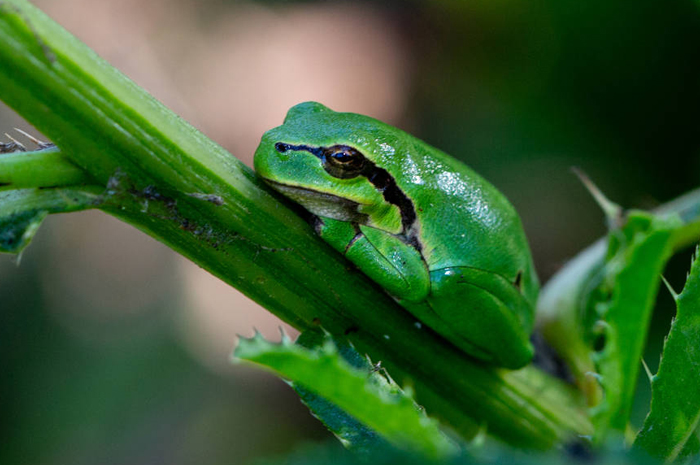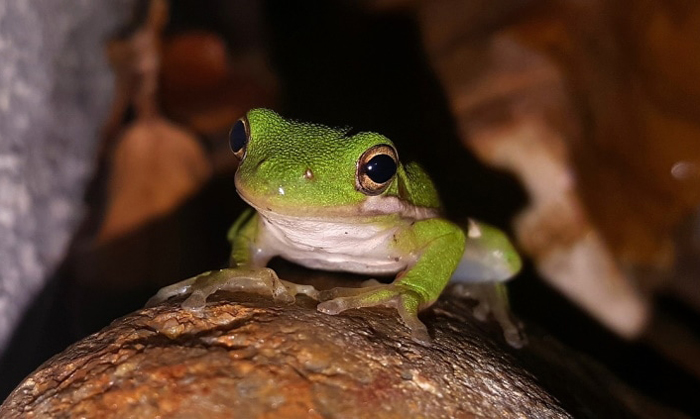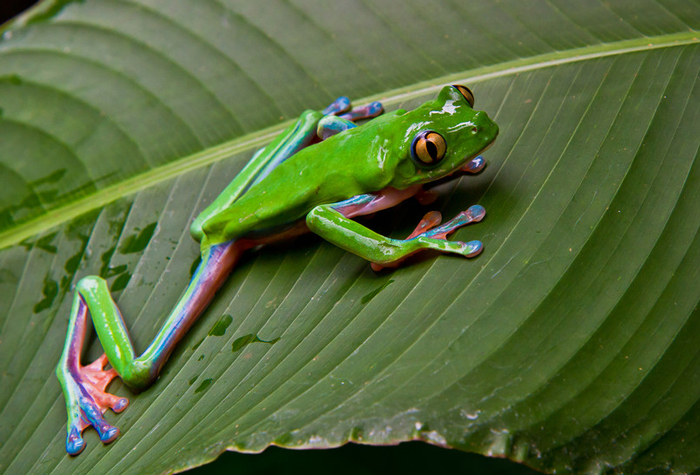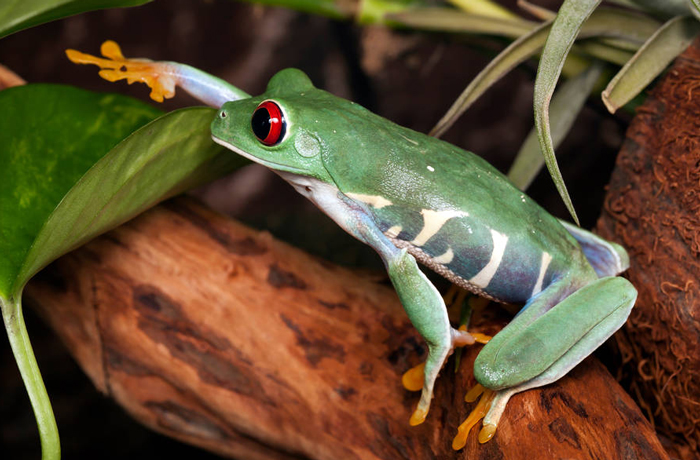In winter Tree frogs have a clever way to stay safe and warm. They slow down their bodies and use very little energy. This helps them conserve resources until the weather gets better. Today, we will finally uncover their secret!
So, where do these little hoppers go in winter? It’s pretty neat. They find snug spots like under leaves, in tree nooks, or even cozy underground hideouts. They sort of take a nap (brumation) and wait for the warmer days.
Explore how tree frogs survive the cold months. Keep reading to understand these tough amphibians!
Where Tree Frogs Go in the Winter: Do They Hibernate?
A fascinating aspect of tree frogs’ winter survival is their ability to go into a state of dormancy known as hibernation. Up to 90% of tree frog populations in the Northeastern United States go into hibernation.
Not all tree frog species hibernate in the same way. Some tree frogs live in tropical regions. They may not experience drastic temperature changes during the winter. As they may not enter into a true hibernation state.

Pet tree frogs may not hibernate like their wild counterparts due to controlled environments. However, some may show hibernation-like behavior, with reduced activity and appetite in winter.
Hibernation is an amazing survival technique that tree frogs have developed to face the challenges of winter. By slowing down their metabolism, lowering their heart rate, and making physical adaptations, tree frogs can brave the cold and emerge once again when spring arrives.
Tree frogs hibernate in various sheltered locations to protect themselves from harsh winter conditions. Here are some common hibernation spots:
- Under Leaves: Tree frogs like to hide under fallen leaves. It is warm and safe for them.
- In Tree Holes: Some tree frogs go inside holes in trees. It is like a cozy bedroom for them.
- Under Rocks and Logs: They also hide under big rocks and pieces of wood. It is like their secret hiding spot.
- In the Ground: Some tree frogs dig a small hole in the dirt. They curl up inside to stay warm.
- In Cracks on Trees: They like to hide in little spaces in the bark of trees. It is like a snug blanket for them.
- In Houses or Sheds: Sometimes, tree frogs find their way into buildings. They hide in corners or under things.
- In Rocks: If there are big rocks around, they might find a comfy spot in the cracks.
- In Burrows: Some tree frogs make a shallow hole in the ground to sleep in. It is like a cozy bed.
Different kinds of tree frogs choose different places to sleep. They find spots that keep them safe and warm during winter.
How Long Do Tree Frogs Hibernate?
The duration of tree frog hibernation varies depending on the species and environmental conditions. Generally, tree frogs enter hibernation when temperatures drop, and they can remain in this state for several months until the weather becomes warmer again.

So, while the length of hibernation can differ, tree frogs are well-equipped to endure the whole winter. Let’s take a closer look at different tree frog species and how they handle winter. Check out their hibernation lengths below:
| Tree Frog Species | Hibernation Length |
|---|---|
| Red-eyed Tree Frog | 3 – 5 months |
| Green Tree Frog | 2 – 3 months |
| White-lipped Tree Frog | 2 – 3 months |
| European Tree Frog | 3 – 4 months |
| Gray Tree Frog | 3 – 4 months |
| Barking Tree Frog | 3 – 5 months |
| Squirrel Tree Frog | 3 – 4 months |
| Pine Barrens Tree Frog | 3 – 5 months |
| Green and Golden Tree Frog | 2 – 3 months |
These hibernation lengths are approximate and can vary based on factors like location, climate, and individual frog health.
What Signs Indicate That a Tree Frog Is Preparing to Hibernate?

Tree frogs exhibit several signs indicating they are preparing to hibernate:
- Reduced Activity: They become less active and sluggish as they prepare for hibernation.
- Change in Appetite: Appetite decreases, and they may eat less or stop feeding altogether.
- Seeking Shelter: They start looking for suitable hibernation sites.
- Changes in Coloration: Some species may display a darker or duller coloration as they prepare to enter hibernation.
- Weight Gain: They may consume more food to build up fat reserves, preparing for the period of reduced activity.
- Seeking Cooler Areas: They tend to move to cooler spots in their enclosure, indicating a preference for lower temperatures.
- Slower Movements: Movements become slower and more deliberate.
- Decreased Vocalizations: Many tree frogs are known for their calls, but they tend to become less vocal as they prepare for hibernation.
- Grooming Behaviour: They may engage in more grooming activities as they ready themselves for dormancy.
- Digging: Some species may exhibit behavior like digging in preparation for hibernation.
Observing these signs can help you understand when a tree frog is getting ready for hibernation.
How Do Tree Frogs Survive in the Winter? The Facts

Tree frogs are winter superheroes. Tree frogs usually hibernate at temperatures between 4 to 10 degrees Celsius (39 to 50 degrees Fahrenheit). They have these mind-blowing physical traits for survival. It is like their own set of superpowers!
Survival During the Hibernation
Many tree frog species, especially those in milder climates, enter a phase of hibernation during the winter. This is like their downtime. Let’s delve into the essential details of how they endure winter during hibernation.

Avoiding Freezing Temperatures:
As temperatures drop, tree frogs seek out secure hiding places. This could include crevices in trees, leaf litter, under bark, or even in human-made structures like wood piles or buildings, underground burrows, or spaces beneath rocks. These concealed spots work against the cold. That creates a comfortable environment for the frogs.
Lowered Body Temperature:
Their body temperature drops close to the ambient temperature, which helps minimize energy expenditure.
Lowering Metabolism and Heart Rate:
As per North Carolina State University researchers, tree frogs slow down their metabolism by up to 70% during hibernation, which helps them save energy and reduces the need for glucose.
Some species can survive on stored fat for extended periods. Certain species can rely on stored fat for long periods. Their heart rate slows down greatly, Sometimes beating only a few times per minute.
By lowering their metabolic and heart rates, tree frogs can live with limited resources and keep their energy reserves until spring comes.
Adaptations for Oxygen Absorption:
Tree frogs respire through their skin. They can absorb oxygen even when their lungs are not actively functioning. This is crucial during hibernation.
Non-Hibernation Survival

Some tree frog species are more inclined to hibernate during winter, while others may or may not enter a state of dormancy. It depends on factors like the species, their environment, and the specific conditions they face. Let’s explore how tree frogs survive the winter in by not hibernating:
- Thermal Buffering: The microclimate within their hiding places often provides a more stable temperature than the external environment. This helps to prevent rapid temperature fluctuations.
- Antifreeze Proteins: Some kinds of tree frogs have special proteins in their blood that work like antifreeze. These special proteins lower the freezing point of their body fluids, keeping ice crystals from forming and protecting their cells.
- Behavioral Changes: Before winter sets in, tree frogs often change their behavior. They may reduce their activity levels, slow down their movements, and decrease feeding. By doing this, they save energy and make sure they go into winter in the best shape.
- Monitoring Environmental Changes: nTree frogs are sensitive to temperature fluctuations and will adjust their behavior accordingly, seeking out warmer or more sheltered areas.
Tree frogs’ adaptations and behaviors can differ based on their species and the environment. Some tree frogs sleep in winter, others might. Though both groups hide in safe places and use their skin to stay moist. This helps them stay warm and hydrated when there isn’t much water around. Man, it is tough for these little guys with climate change messing things up.
Hibernating Tree Frogs’ Behavior: Can Tree Frogs Die during Hibernation?

Tree frogs can die during hibernation. Hibernation is a critical period in an amphibian’s life cycle. If it is not managed properly, it can lead to various health issues and even death.
By the way, sometimes, people can mistakenly think a hibernating tree frog has passed away. Recognizing the difference between a hibernating and a deceased tree frog is very important. So, knowing how to spot the signs of a truly expired tree frog in winter is crucial.
If you find yourself uncertain about whether a tree frog is in hibernation or has passed away, consider the following indicators to confirm if it has passed away:
- Swollen abdomen
- Dull coloring
- Protruding tongue
- Presence of skin fungus
- Closed eyes
- motionless
- No observable breathing
While hibernating tree frogs do not display responsiveness or movement, it is important to note that their internal organ activity remains ongoing.
See how frogs hibernate in the following video.
What Are the Risks of Hibernating a Tree Frog in Captivity?
Hibernating a tree frog in captivity can be risky. This is because the frog’s surroundings may not match their natural conditions, causing stress and health problems.

See what types of consequences captive tree frogs can face if they hibernate.
- Captive environments issues: The hibernating surroundings might not recreate the natural hibernation conditions accurately. This can cause problems for a particular tree frog species. These problems can lead to stress and health issues. Let’s explore some specific examples of different tree frog species:
- Gray Tree Frog (Hyla versicolor): Inadequate temperature and humidity levels can disrupt their hibernation cycle, leading to metabolic stress.
- Spring Peeper (Pseudacris crucifer): Incorrect lighting conditions and photoperiod changes can induce stress and affect their hibernation patterns.
- Pacific Chorus Frog (Pseudacris regilla): Overcrowded enclosures and lack of hiding spots can lead to stress during hibernation.
- European Tree Frog (Hyla arborea): Inadequate diet and nutrition before hibernation can lead to weakened states and health issues.
- Boreal Chorus Frog (Pseudacris maculata): Lack of monitoring and professional care can lead to undetected health issues during hibernation.
- Inadequate Nutrition: It’s really important for the frog to have plenty of fat stored up before hibernation. If they go into hibernation without enough food, it could make them weak or even cause them to die.
- Health Issues: If tree frogs already have health issues, these issues or infections can become worse during hibernation. This happens because their immune systems are suppressed at that time.
- Disturbances: Environmental disturbances or changes in temperature and lighting can wake a hibernating frog prematurely, causing stress.
- Difficulty Monitoring: Keeping an eye on a frog’s health and well-being during hibernation can be tricky. This makes it more difficult if an issue comes up.
- Re-Entry Problems: It is crucial for the frog to wake up from hibernation and go back to normal activity. If this doesn’t happen properly, it can cause problems after hibernation.
Conclusion
In summary, tree frogs have incredible strategies for facing the challenges of winter. Many of them go into a special sleep called hibernation, where they slow down their bodies to conserve energy. This helps them endure the cold temperatures. These superheroes have amazing adaptations like antifreeze proteins and behavioral changes to save energy.
However, tree frogs face new challenges today. Climate change and disruptions to their habitats make it harder to find the right places to hibernate. It is important to set up a perfect environment for them. Taking good care of them during this critical time in their lives is crucial for their well-being.

Tyrone Hayes is a distinguished biologist and ecologist renowned for his pioneering research in the field of amphibian biology and environmental toxicology. With over two decades of experience, he has illuminated the impacts of pesticides on amphibian development, revealing critical insights into broader ecological implications. Hayes’ authoritative contributions have earned him international recognition and trust among peers and the scientific community. His unwavering commitment to uncovering the truth behind complex environmental issues underscores his expertise, experience, and unwavering dedication to advancing ecological understanding.
